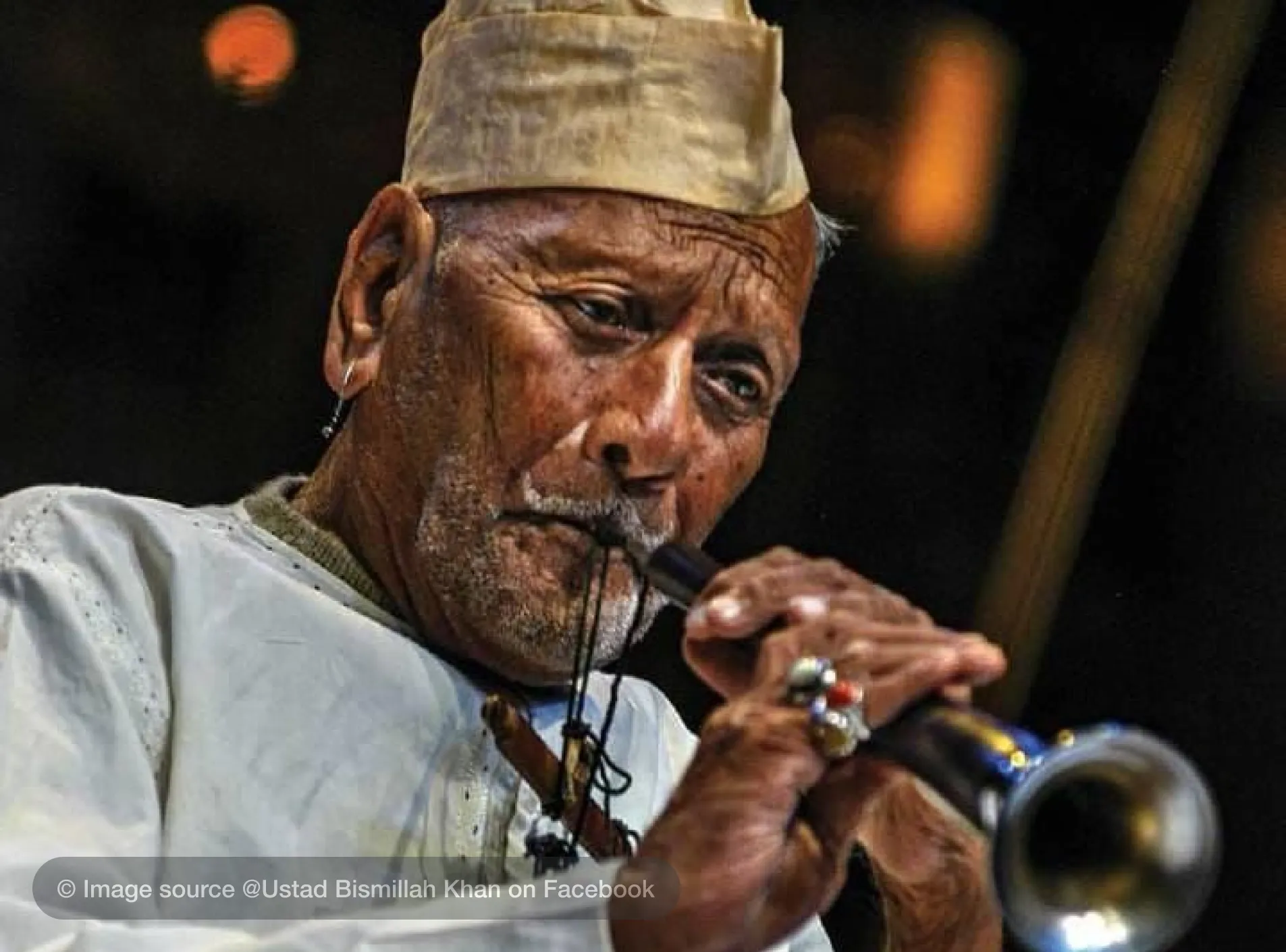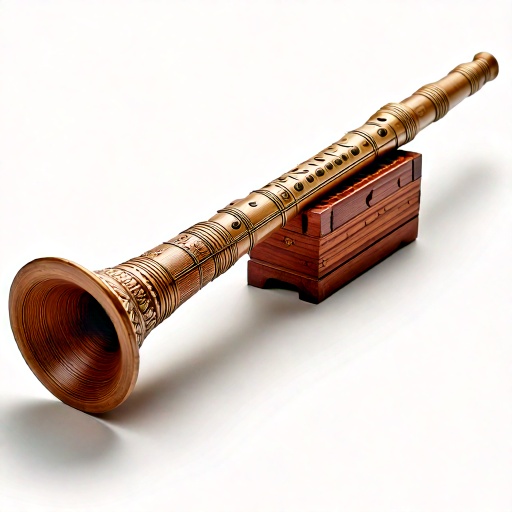Overview of the Shehnai Musical Instrument
The Shehnai is a well-known and soulful wind instrument from India, with roots in classical and folk music. The Shehnai musical instrument is for weddings, temple rituals, and auspicious events because of its rich, penetrating, and melodic tone, which is thought to bring good fortune. This traditional instrument, which is frequently used in North Indian classical music, has been an important part of India's cultural history for generations, filling the air with a distinct blend of devotion and celebration.
Similar to the oboe, the Shehnai is a double-reed aerophone that is mostly employed in Hindustani classical music. It is made of a hollow hardwood body that gradually widens near the end, giving a resonant and expressive tone. Though its beginnings can be traced back to the folk traditions, the Shehnai rose to the status of classical music, largely due to the contributions of Ustad Bismillah Khan. His mastery of the instrument not only elevated it to the status of a prestigious solo concert instrument but also earned it international acclaim. Despite its deep classical roots, the Shehnai has evolved and is now used in current and fusion music.
History and Origin of Shehnai
The Shehnai has a long and fascinating history, dating back to ancient India. Its origins can be traced back to the Pungi, a primitive folk instrument sometimes used by snake charmers. While the Pungi had a harsh, reedy tone, it evolved over time into a more refined and beautiful sound, giving rise to the Shehnai. This modification made the instrument more appropriate for temple rituals, royal courts, and festive occasions, resulting in its link with auspicious events like weddings and religious celebrations.
Historians think the Shehnai originated and evolved in North India, particularly in Varanasi and Lucknow, where it became an essential component of classical and ceremonial music.
Etymology and Cultural Significance of Shehnai
The name Shehnai comes from two Persian words:
- Shah means "king" or "royalty"
- Nai meaning "flute" or "reed instrument"
This shows that the Shehnai was previously regarded as the "royal flute," an instrument used in the courts of kings, emperors, and noble families on special occasions. According to historical accounts, the Shehnai was performed before Mughal emperors and Rajput monarchs, frequently as part of their royal ensembles. It was performed at significant occasions, courtly festivities, and military victories to lend grandeur and prestige to the proceedings.
One of the reasons for the Shehnai's distinguished reputation was its rich and piercing sound, which could cut through the bustle of huge crowds and fill the grand halls of palaces with powerful, yet lyrical tones. The instrument was frequently played during royal processions, weddings, and coronation ceremonies to represent affluence, divinity, and good fortune.
 Beyond its significance in royal courts, the Shehnai evolved into an important component of India's spiritual and cultural traditions. Hindu temples adopted the instrument, incorporating it into their daily and evening aartis (prayer ceremonies). The sound of the Shehnai was thought to generate a spiritual connection, making it a popular instrument at religious festivals and processions.
Beyond its significance in royal courts, the Shehnai evolved into an important component of India's spiritual and cultural traditions. Hindu temples adopted the instrument, incorporating it into their daily and evening aartis (prayer ceremonies). The sound of the Shehnai was thought to generate a spiritual connection, making it a popular instrument at religious festivals and processions.
Also, the Shehnai became a representation of good beginnings, which is why Indian weddings frequently use it. Even today, the soulful melodies of the Shehnai accompany the arrival of the groom in North Indian wedding processions (Baraat), symbolizing joy, peace, and a prosperous future for the couple. This tradition has persisted for generations, establishing the instrument's deep link to ceremonial and holy events.
While it was once limited to temple courtyards and palace halls, it has now found a home in concert performances, film music, and experimental fusion genres, proving its versatility and everlasting appeal.
Parts of Shehnai Explained
The Shehnai is a conical wooden wind instrument with a metal bell on the end. It features numerous components that contribute to its distinctive sound:
Reed
The most important component of the Shehnai is the reed, also known as the Munh Singar or Jivala, which makes the sound when air is blown through it. The Shehnai is often crafted from a beautifully cut piece of cane or palm leaf and has a double-reed system with two thin reeds positioned near together. When the player blows air into the instrument, the reeds vibrate against one another, producing the Shehnai's characteristic sound. The reed's quality and thickness have a considerable impact on the instrument's timbre and tonal richness.
Mouthpiece
The mouthpiece (Seh) is a passage through which the player blows air into the Shehnai. Unlike Western wind instruments, the Shehnai does not have a removable mouthpiece, instead, the reed serves as the blowing mechanism. To control airflow and produce clear, sustained notes, musicians must develop a unique embouchure (lip technique). The air pressure and blowing angle control the pitch, loudness, and expression of the notes. A proficient Shehnai player can use breath control to generate embellishments like meend (glides), gamakas (ornamental oscillations), and murkis (grace notes), all of which contribute to the expressive element of Hindustani classical music.
Body
The Shehnai's hardwood body, or Bhaat, acts as the resonating chamber, and it plays a crucial role in creating its warm and full-bodied tone. The instrument's sound quality and durability are improved by its hardwood construction, which is traditionally built of ebony, rosewood, or teak. The Shehnai has a gradually widening conical bore that amplifies and improves the sound as it goes through the instrument, resulting in its distinctive lyrical and penetrating tone. The length of the Shehnai varies, but a typical instrument is 12 to 20 inches (30 to 50 cm) long. The conical shape of the Shehnai makes it different from the straight-bodied Pungi (been) used by snake charmers. This provides it a more refined tonal quality and dynamic range, making it suitable for both folk and classical performances.
Bell
The flared bell (Khol) at the end of the Shehnai acts as a sound amplifier, projecting and enriching the instrument's tone. The bell, which is traditionally made of brass, copper, or wood, increases the resonance and volume of the Shehnai's sound, allowing it to be carried well in open-air events, temples, and big gatherings. Some modern Shehnais use silver or other metals for aesthetic appeal and tonal variety. The form and substance of the bell can have a slight impact on the sound quality, and some Shehnai players make subtle changes to obtain a specific tone that fits different musical styles and situations.
Shehnai Playing Technique
For the Shehnai to produce its very expressive and melodic sound, it requires fine breath control and complex finger movements. Here's how to play:
The Blowing Technique
It involves directing air through the double reed, causing it to vibrate and produce sound. Unlike a flute, the Shehnai demands direct airflow through the reed. Controlling breath pressure is essential since it influences the instrument's pitch, loudness, and tone texture. Skilled performers can use their breath to generate subtle expressions like smooth glides (meend) and ornamental oscillations (gamakas), which are essential in Hindustani classical music.
Finger Positioning and Note Production
Notes on the Shehnai are created by covering and uncovering the finger holes in various combinations. The instrument normally has six to nine finger holes, each of which controls the pitch when covered or partially uncovered. Because the Shehnai lacks mechanical keys common in Western wind instruments, the musician must rely only on finger flexibility and precise motions to play the notes. This manual control allows more freedom, allowing players to create microtonal shifts, which are essential in Indian classical music.
Ornamentation (Meend, Gamak)
One of the distinguishing characteristics of Shehnai music is the complex ornamentation used to spice up songs. Players use methods like meend (glides between notes) and gamak (oscillations or rapid alternation between notes) to create depth and emotion. These embellishments are critical in presenting Indian ragas because they capture the subtle tone fluctuations that bring a piece of music to life. The ability to perform these complexities with skill distinguishes an experienced Shehnai player from a beginner.
Circular Breathing
Advanced Shehnai players frequently use circular breathing, a method that enables them to prolong long phrases without interruption. Circular breathing involves inhaling through the nose while pushing air from the cheeks into the instrument. This allows the performer to create an uninterrupted flow of sound, which is especially important in classical music, where long, continuous notes are necessary. Mastering this technique requires years of diligent practice and is the signature of highly talented Shehnai artists.
Accompaniment
Traditionally, the Shehnai is accompanied by pakhawaj or tabla, which add energy to the performance and provide rhythmic support. The tanpura is also employed in Shehnai recitals to generate a continuous drone, which helps maintain the tone of the raga being performed. These accompanying instruments give the Shehnai's melodic themes a solid basis and support in establishing the composition's mood. It is possible to play many Shehnais simultaneously during ensemble performances, which enhances the overall sound texture.
Famous Shehnai Players
Following famous Shehnai players have contributed to the popularity and evolution of the Shehnai:
- Ustad Bismillah Khan
- Ali Ahmed Hussain Khan
- Daya Shankar
- Anant Lal
